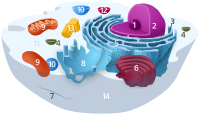
Photo from wikipedia
Diabetic kidney disease (DKD), the leading cause of chronic kidney disease, is characterized by accumulation of renal tubule free fatty acids (FFAs) and triglyceride (TG)-enriched lipid droplets (LDs) and cell… Click to show full abstract
Diabetic kidney disease (DKD), the leading cause of chronic kidney disease, is characterized by accumulation of renal tubule free fatty acids (FFAs) and triglyceride (TG)-enriched lipid droplets (LDs) and cell death. The present study aimed to investigate how FFA or TG induces renal tubular cell apoptosis, thereby contributing to the progression of DKD. Cell studies were conducted to define the causal role and underlying mechanism of FFA-activated ER stress and organelle dysfunction in tubular cell injury. Six-week-old wild-type (WT) and eNOS-deficient C57BL/6J mice were placed on normal diet (ND, 5% fat calories) or high-fat diet (HFD, 42% fat calories) for two weeks, and then rendered diabetic with alloxan. Alloxan injection resulted in equivalent hyperglycemia in ND and HFD-fed WT and eNOS-deficient mice. However, a massive increase in urinary albumin was observed in HFD plus alloxan-treated eNOS-deficient mice, which was accompanied by excessive accumulation of neutral lipids in damaged proximal tubules. Moreover, in the diabetic eNOS-deficient kidneys, HFD feeding resulted in suppression of autophagy-lysosomal function and increase in tubular cell apoptosis. Cell studies revealed that saturated FFA palmitate but not unsaturated oleate induced eukaryotic initiation factor (eIF)2α phosphorylation, and then stimulated the activating transcription factor (ATF)4 and C/EBP homologous protein (CHOP), which, in turn, impaired autophagy-lysosomal function, leading to cell apoptosis. In addition, we observed a dramatic upregulation of LD-associated protein ADRP expression and TG-enriched LD formation in oleate-treated renal tubular cells, which was not apparent in palmitate-treated ones. Together, this study demonstrates that accumulation of renal FFA, rather than TG, plays a crucial role in the pathogenesis of diabetic kidney injury by suppressing autophagy-lysosomal function through ER stress signaling. This work was supported by the National Institutes of Health Grants SC1DK112151 and S21MD000101. This is the full abstract presented at the American Physiology Summit 2023 meeting and is only available in HTML format. There are no additional versions or additional content available for this abstract. Physiology was not involved in the peer review process.
Journal Title: Physiology
Year Published: 2023
Link to full text (if available)
Share on Social Media: Sign Up to like & get
recommendations!